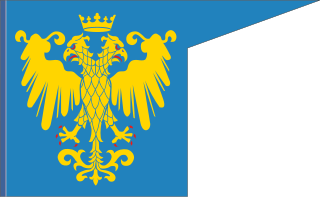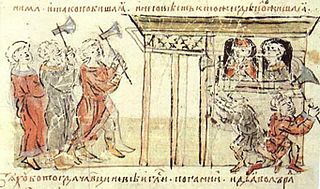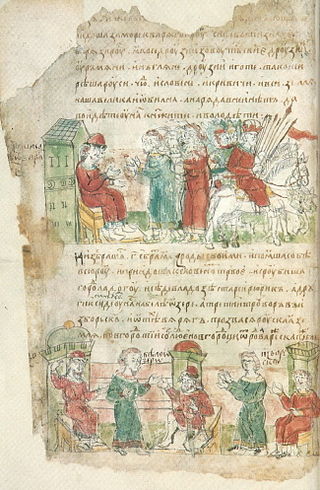Related Research Articles

The Primary Chronicle, shortened from the common Russian Primary Chronicle, is a chronicle of Kievan Rus' from about 850 to 1110. It is believed to have been originally compiled in or near Kiev in the 1110s. Tradition ascribed its compilation to the monk Nestor beginning in the 12th century, but this is no longer believed to have been the case.

The Cherven Cities, Czerwień Cities or Cherven Gords ), often literally translated as Red Cities, Red Forts or Red Boroughs, was a point of dispute between the Kingdom of Poland and Kievan Rus' at the turn of the 10th and 11th centuries, with both sides claiming their rights to the land.

Nestor the Chronicler or Nestor the Hagiographer was a monk from the Kievan Rus who is known to have written two saints' lives: the Life of the Venerable Theodosius of the Kiev Caves and the Account about the Life and Martyrdom of the Blessed Passion Bearers Boris and Gleb.

Askold and Dir, mentioned in both the Primary Chronicle, the Novgorod First Chronicle, and the Nikon Chronicle, were the earliest known rulers of Kiev.

Chud or Chude is a term historically applied in the early East Slavic annals to several Baltic Finnic peoples in the area of what is now Estonia, Karelia and Northwestern Russia. It has also been used to refer to other Finno-Ugric peoples.

Kyi, Shchek and Khoryv were three legendary brothers—often mentioned along with their sister Lybеd' —who, according to the Primary Chronicle, founded the city of Kiev, which eventually became the capital of Kievan Rus', and is the present-day capital of Ukraine.
Aepa is the name of at least two early 12th-century Cuman (Polovtsi) princes mentioned in Rus' chronicles.
The family of Vladimir I, popularly known as Vladimir the Great, prince of Kievan Rus', is subject to scholarly studies. The primary sources about his life, such as the Primary Chronicle and the Chronicon Thietmari of Thietmar of Merseburg, are legendary, and require critical scrutiny to separate fact from fiction.
Sveneld, is a semi-legendary 10th-century Varangian warlord in the service of Sviatoslav I and his family. Most of the information about Sveneld is scarce. He is described as a rich man and a voevoda of Kievan Rus', but his relation to the reigning Rurikid princes, if it existed, has not been positively established.

The Rus'–Byzantine Treaty of 911 is the most comprehensive and detailed treaty which was allegedly concluded between the Byzantine Empire and Kievan Rus' in the early 10th century. It was preceded by the preliminary treaty of 907. It is considered the earliest written source of Kievan Rus' law. The text of this treaty is only found in the Primary Chronicle (PVL), and its authenticity is therefore difficult to establish.
The Battle of Listven (1024) was part of the aftermath of the Kievan succession crisis of 1015–1019 following the death of Vladimir the Great (Volodymyr) in 1015. It was fought between his sons Mstislav of Chernigov and Kievan forces supporting Yaroslav the Wise; Mstislav defeated Yaroslav. The battle is mainly known from the account written under the year 6532 (1024) in the Primary Chronicle, completed about 90 years later. According to that legendary narrative, the battle took place at night during a thunderstorm.
The Prince of Pereyaslavl was the ruler of the Principality of Pereyaslavl, a lordship based on the city of Pereyaslavl on the Trubizh River, and straddling extensive territory to the east in what are now parts of Ukraine. It was situated on the southern frontier of Kievan Rus' and bordered the steppe.

The Principality of Peremyshl was a medieval petty principality centred on Peremyshl in the Cherven lands.

Theodore the Varangian and his son John are the names traditionally attributed to a Varangian Christian man from Greece and his young son living in Kiev, who were killed in a story recorded in the Primary Chronicle under the year 6491 (983). The chronicle glorifies their deaths as examples of Christian martyrs who suffered persecution by the pagan establishment of Kievan Rus' during the reign of prince Vladimir the Great.
Kyi dynasty, also known as the Kyivites was allegedly a dynasty of early medieval Polans rulers of Kyiv.

The calling of the Varangians, calling of the (Varangian) princes or invitation to the Varangians is a legend about the origins of the Rus' people, the Rurik dynasty and the Kievan Rus' state, recorded in many divergent versions in various manuscripts and compilations of Rus' chronicles. These include the six main witnesses of the Primary Chronicle and the Novgorod First Chronicle (NPL), as well as later textual witnesses such as the Sofia First Chronicle and the Pskov Third Chronicle.
The Conversion of Volodimer is a narrative recorded in several different versions in medieval sources about how Vladimir the Great converted from Slavic paganism to Byzantine Christianity in the 980s.

Predslava Volodimerovna was a princess from Kievan Rus', daughter of Volodimer' I of Kiev and Rogned', concubine of Bolesław I the Brave, and sister of Yaroslav the Wise. She is one of the few named women who appear in the Primary Chronicle (PVL).

The Battle of the Alta River was a battle that took place on 24 July 1019 between the troops of the Novgorodian prince Yaroslav "the Wise" Volodimerovich and the army of his brother, prince Sviatopolk I of Kiev, who was supported by the Pechenegs. It was part of the Kievan succession crisis of 1015–1019.

The Feud of the Sviatoslavichi was a war of succession in Kievan Rus' in the late 970s, between the sons of the Kievan prince Sviatoslav I Igorevich, for 'eldership' after the death of their father.
References
- ↑ Cross & Sherbowitz-Wetzor 1953, p. 124.